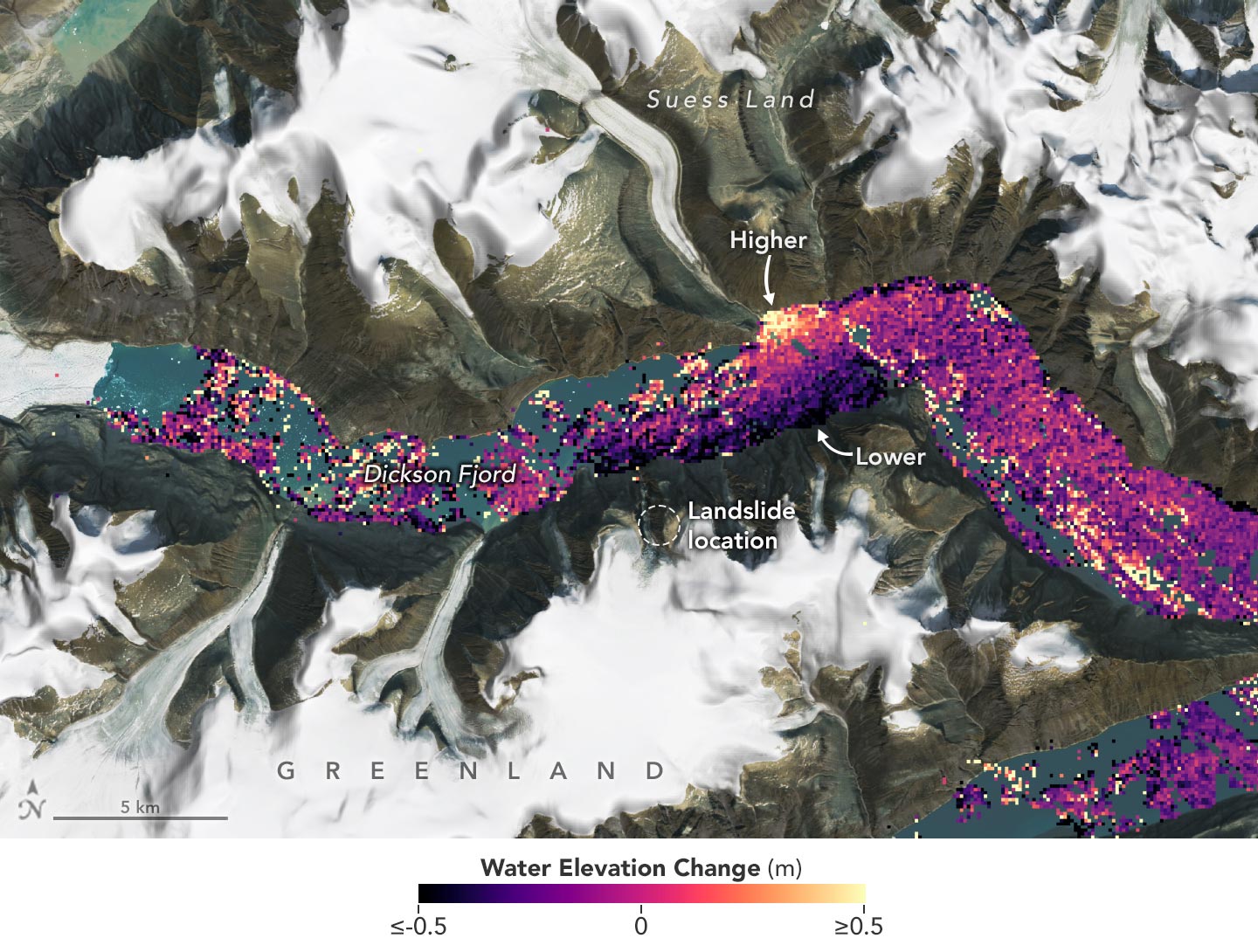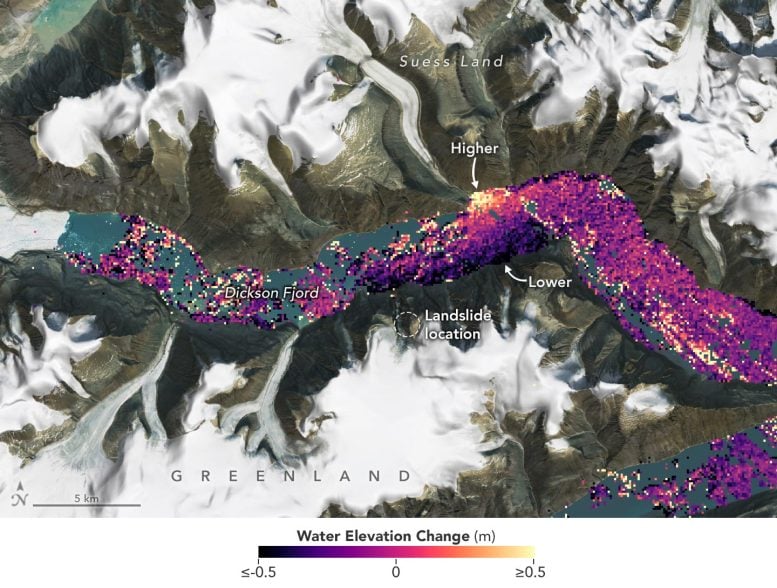

Satellite data show the shape of a wave as water sloshed around Dickson Fjord after a rockslide triggered a tsunami.
The SWOT satellite captured the unique effects of a tsunami in Greenland’s Dickson Fjord in September 2023. Triggered by a massive rockslide, the event was marked by dramatic changes in water elevation and provided unprecedented insights, thanks to the advanced radar technology onboard.
Unveiling the Tsunami: An International Satellite Mission
In September 2023, an international satellite mission detected the unique contours of a tsunami that surged within the steep walls of a Greenland fjord. This tsunami, triggered by a massive rockslide, sent seismic vibrations reverberating across the globe for nine days. A team of scientists, including seismologists, geophysicists, and oceanographers, recently released their findings after a year of data analysis.
The event was captured by the SWOT (Surface Water and Ocean Topography) satellite, a collaboration between NASA and France’s CNES (Centre National d’Études Spatiales). On September 17, 2023, a day after the rockslide and tsunami, the satellite recorded water elevation changes in Dickson Fjord, comparing them with baseline measurements taken on August 6, 2023, under normal conditions.
In this data visualization, orange and yellow indicate higher-than-normal water levels, and purple and black indicate lower levels. For context, water elevation measurements are overlaid on an image of the fjord acquired by the OLI-2 (Operational Land Imager-2) on the Landsat 9. The data suggest that water levels along the north side of the fjord were as much as 1.2 meters (4 feet) higher than on the south side at some points.
Insights from the Fjord’s Waters
“SWOT happened to fly over at a time when the water had piled up pretty high against the north wall of the fjord,” said Josh Willis, a sea level researcher at NASA’s Jet Propulsion Laboratory in Southern California. “Seeing the shape of the wave—that’s something we could never do before SWOT.”
In a paper published recently in Science, researchers traced a seismic signal back to a tsunami that began when more than 25 million cubic meters (880 million cubic feet) of rock and ice fell into Dickson Fjord. Part of a network of channels on Greenland’s eastern coast, the fjord is about 540 meters (1,772 feet) deep and 2.7 kilometers (1.7 miles) wide, with walls taller than 1,830 meters (6,000 feet).
Monitoring Water Surfaces From Space
Far from the open ocean, in a confined space, the energy of the tsunami’s motion had limited opportunity to dissipate, so the wave moved back and forth about every 90 seconds for nine days. It caused tremors recorded on seismic instruments thousands of miles away.
From about 900 kilometers (560 miles) above, SWOT uses its sophisticated Ka-band Radar Interferometer (KaRIn) instrument to measure the height of nearly all water on Earth’s surface, including the ocean and freshwater lakes, reservoirs, and rivers.
“This observation also shows SWOT’s ability to monitor hazards, potentially helping in disaster preparedness and risk reduction,” said SWOT program scientist Nadya Vinogradova Shiffer at NASA Headquarters.
It can also see into fjords, as it turns out.
“The KaRIn radar’s resolution was fine enough to make observations between the relatively narrow walls of the fjord,” said Lee-Lueng Fu, the SWOT project scientist. “The footprint of the conventional altimeters used to measure ocean height is too large to resolve such a small body of water.”
For more on this research, including images and video, see Shocking Waves From Greenland: The Tsunami Felt Around the World for 9 Days.
Reference: “A rockslide-generated tsunami in a Greenland fjord rang Earth for 9 days” by Kristian Svennevig, Stephen P. Hicks, Thomas Forbriger, Thomas Lecocq, Rudolf Widmer-Schnidrig, Anne Mangeney, Clément Hibert, Niels J. Korsgaard, Antoine Lucas, Claudio Satriano, Robert E. Anthony, Aurélien Mordret, Sven Schippkus, Søren Rysgaard, Wieter Boone, Steven J. Gibbons, Kristen L. Cook, Sylfest Glimsdal, Finn Løvholt, Koen Van Noten, Jelle D. Assink, Alexis Marboeuf, Anthony Lomax, Kris Vanneste, Taka’aki Taira, Matteo Spagnolo, Raphael De Plaen, Paula Koelemeijer, Carl Ebeling, Andrea Cannata, William D. Harcourt, David G. Cornwell, Corentin Caudron, Piero Poli, Pascal Bernard, Eric Larose, Eleonore Stutzmann, Peter H. Voss, Bjorn Lund, Flavio Cannavo, Manuel J. Castro-Díaz, Esteban Chaves, Trine Dahl-Jensen, Nicolas De Pinho Dias, Aline Déprez, Roeland Develter, Douglas Dreger, Läslo G. Evers, Enrique D. Fernández-Nieto, Ana M. G. Ferreira, Gareth Funning, Alice-Agnes Gabriel, Marc Hendrickx, Alan L. Kafka, Marie Keiding, Jeffrey Kerby, Shfaqat A. Khan, Andreas Kjær Dideriksen, Oliver D. Lamb, Tine B. Larsen, Bradley Lipovsky, Ikha Magdalena, Jean-Philippe Malet, Mikkel Myrup, Luis Rivera, Eugenio Ruiz-Castillo, Selina Wetter and Bastien Wirtz, 12 September 2024, Science.
DOI: 10.1126/science.adm9247
NASA Earth Observatory image by Lauren Dauphin, using SWOT data provided by the SWOT science team, Landsat data from the U.S. Geological Survey, and Digital Elevation Model data from ArcticDEM. Story by Andrew Wang, NASA’s Jet Propulsion Laboratory, adapted for NASA Earth Observatory.

